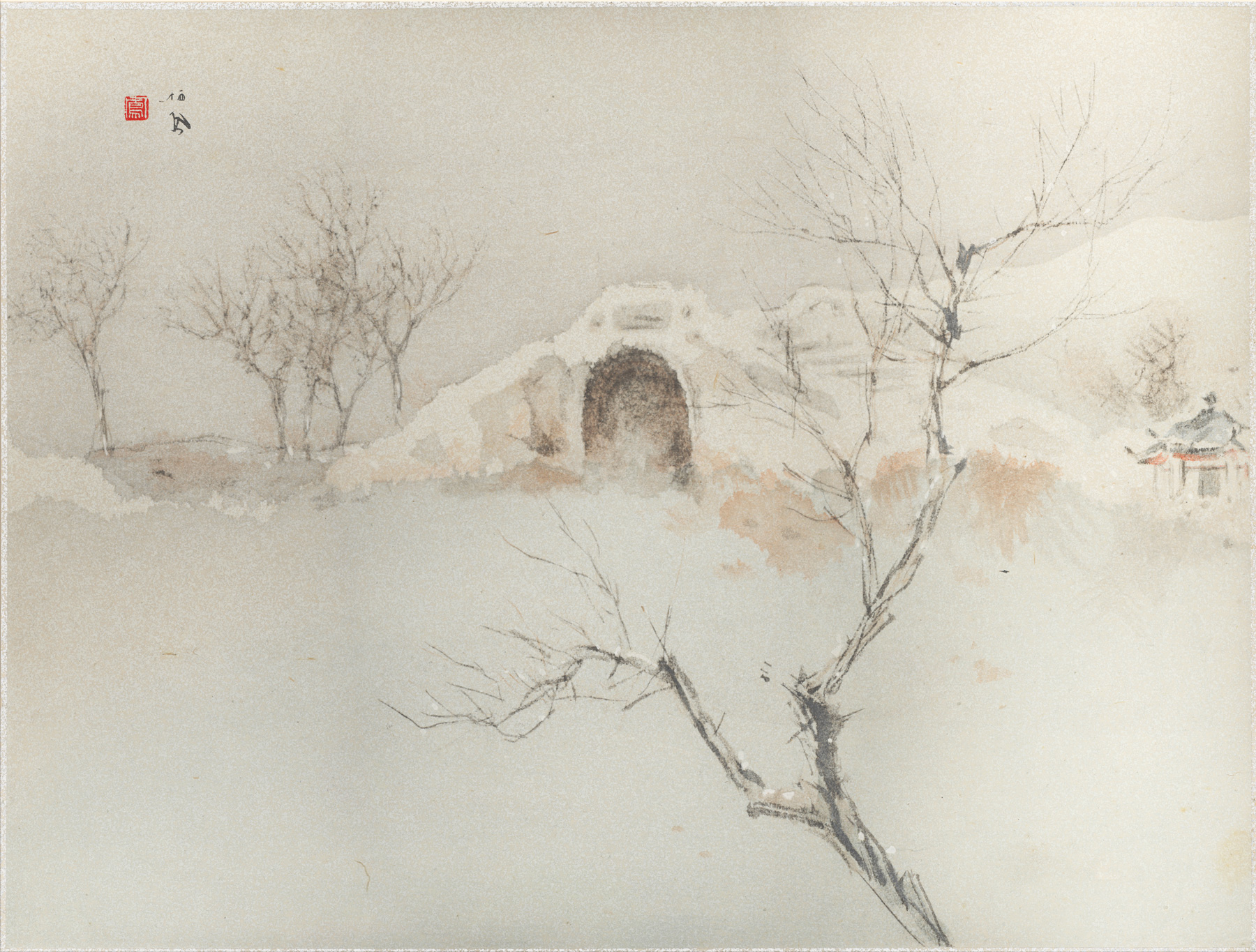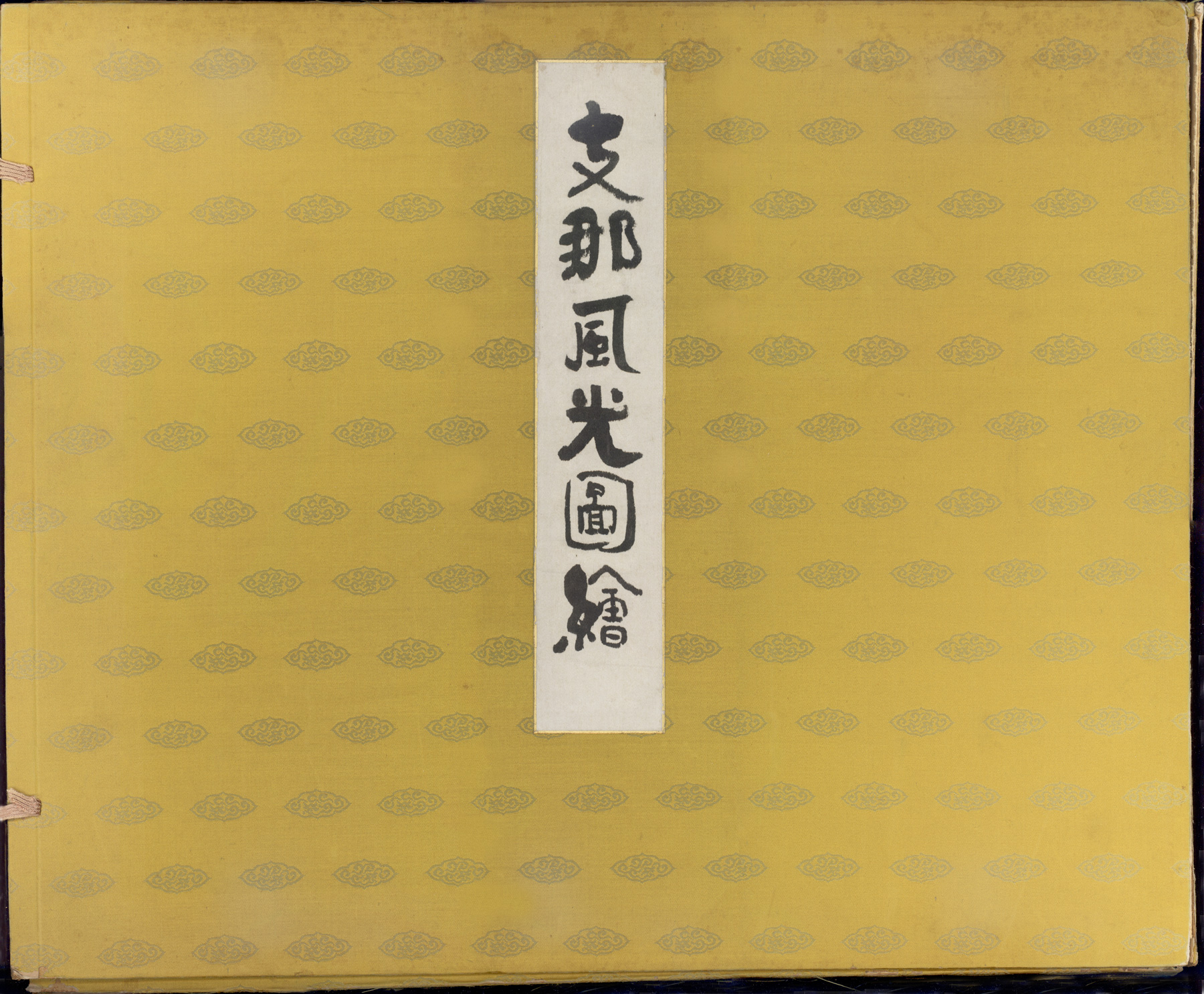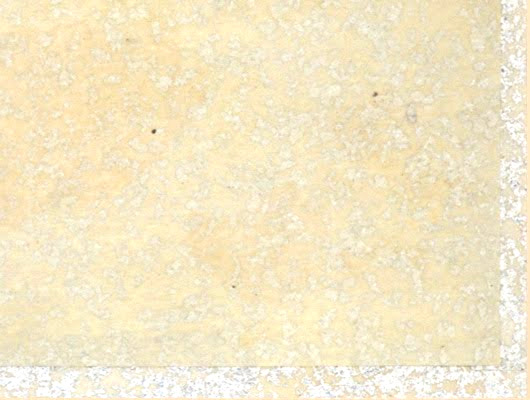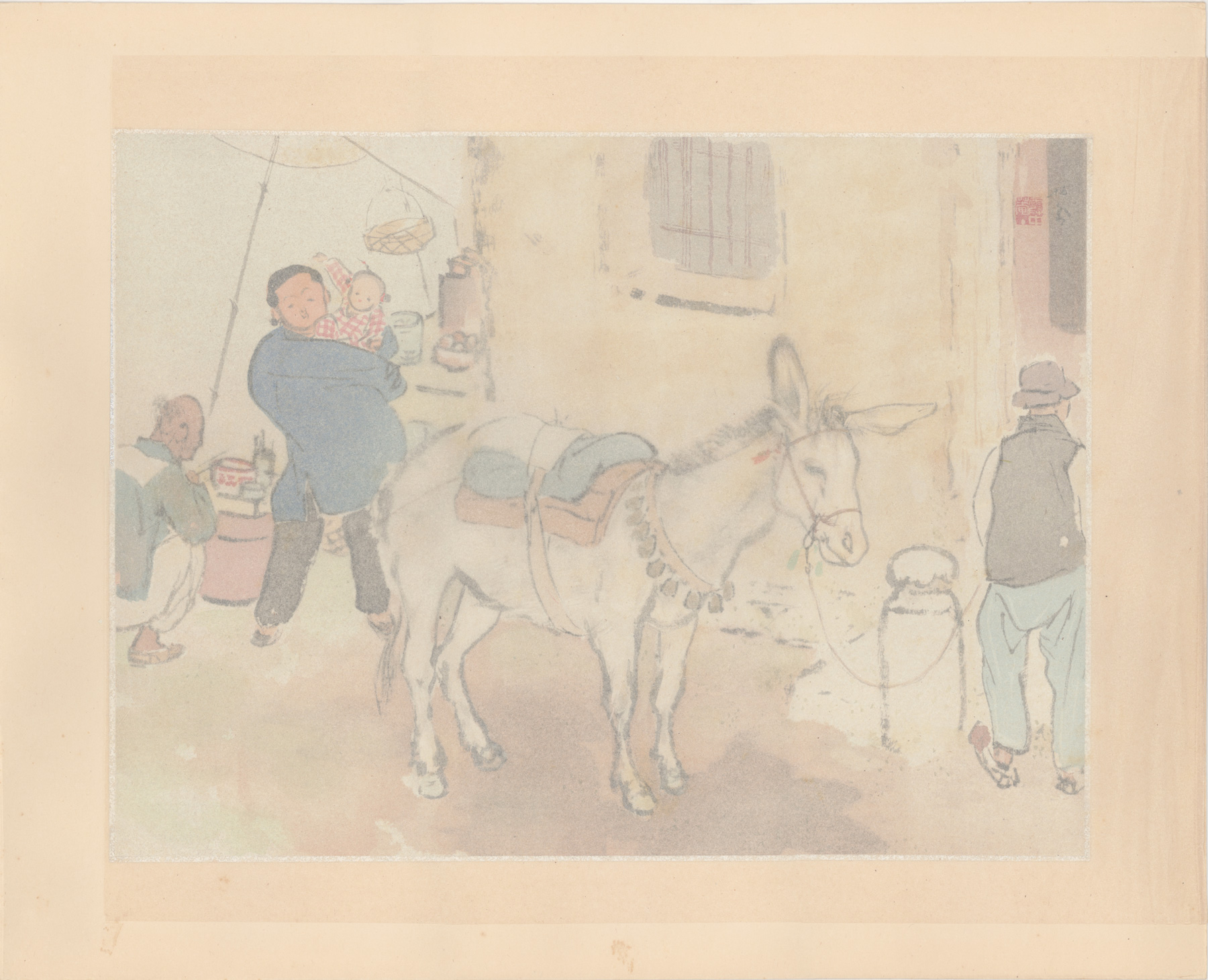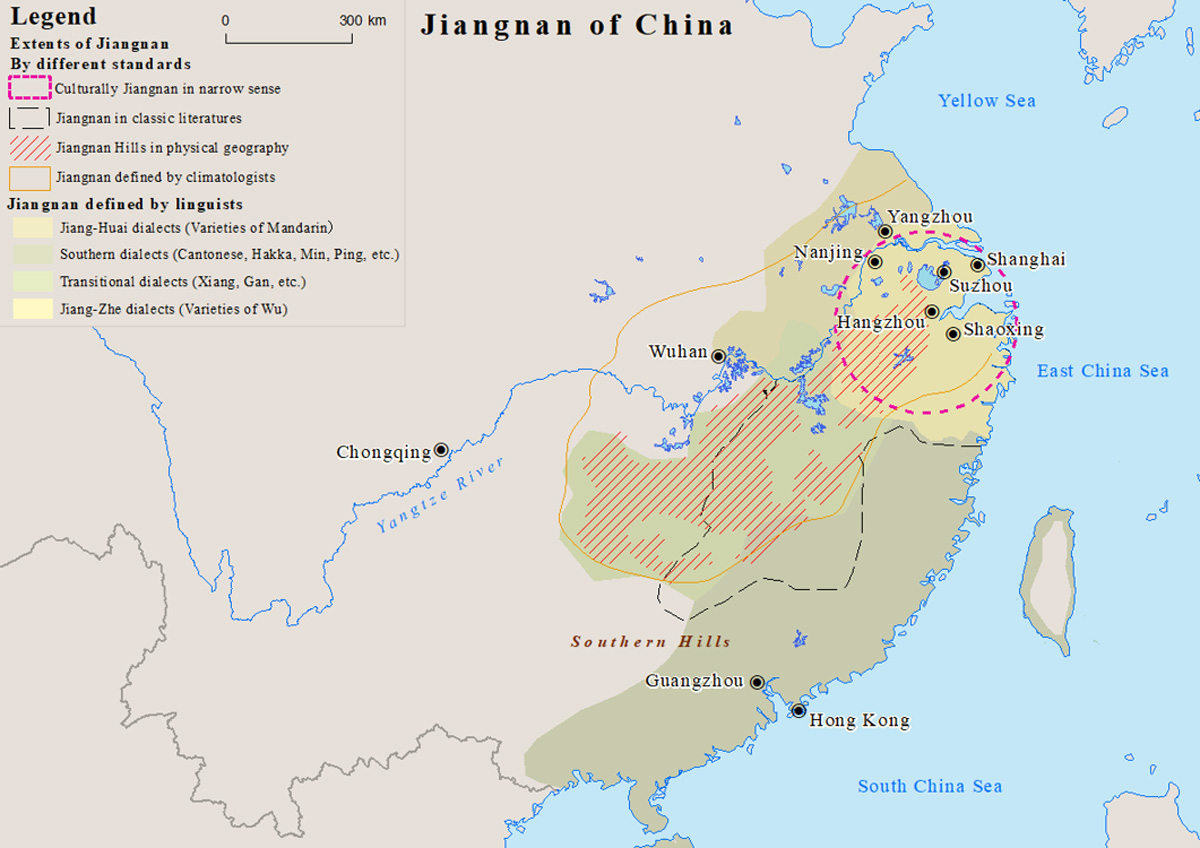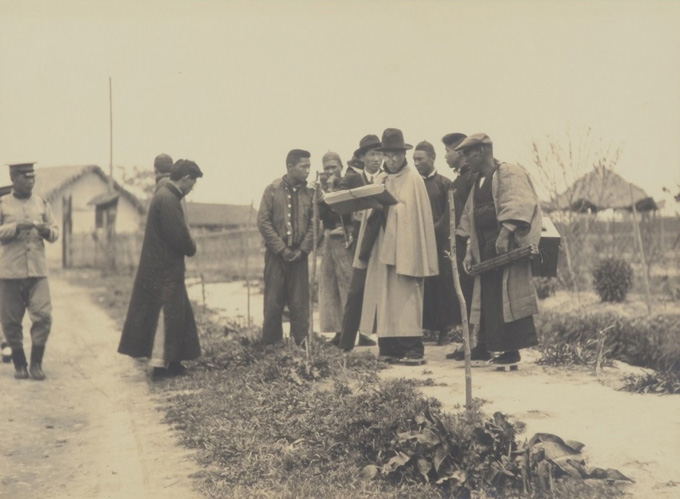About This Print and the Portfolio "Shina fūkō zue"
West Lake, Hangzhou (Duan Bridge) is one of twelve prints that make up the portfolio Scenes of China published in 1936 by the Tokyo publisher Ōtsuka Minoru whose firm specialized in collotype reproduction1. For these prints it appears that the collotype backgrounds have been overlaid with woodblock printing for the foreground to produce exquisite reproductions of designs by the Kyoto nihonga artist Takeuchi Seihō (1864-1942). This print portfolio produced towards the end of Seihō's career, reproduced his original ink on silk paintings created after his two trips to China in 1920 and 1921. As further discussed on Seihō's biography page, Takeuchi Seihō (1864-1942), his visit to China was a seminal journey for Seihō in evolving his style, as was his visit to Europe ten years earlier.
This is the only print in the portfolio for which I've come across an image (see below) of the original ink on silk painting the print replicated. The painting auctioned in March 2015 and carried the made-up title "Winter Sky."
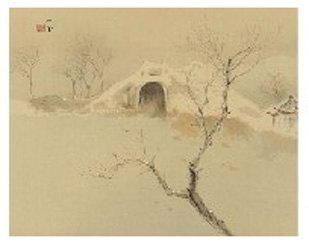
ink and color on silk
45 x 57 cm (17,7 x 22,4 in)
source: http://www.artnet.de/k%C3%BCnstler/seiho-takeuchi/winter-sky-mSqHMUJlkvH4lk-96kTbEQ2
Portfolio covered with silk brocade housing the twelve prints.
IHL Cat. #2458
17 x 21 1/4 x 3/4 in. (43.2 x 54 x 19.1 cm)
Each print varies in size. Typical measurements 12 1/2 x 16 3/4 in. (31.8 x 42.5 cm)
Print Titles
Print titles in Japanese are printed on small labels pasted on the verso of each print.
Translations are my own.
上海小艇 Shanghai Dinghy 江南龍華寺 Longhua Temple, Jiangnan 西湖斷橋 West Lake Hangzhou [Duan Bridge (Broken Bridge)] 蘇州雙塔寺 Sūzhōu Twin Pagoda Temple 長江一望 View of the Yangtze River 蘇州街頭 Sūzhōu Street 鎭江泊舟 Zhenjiang, Boats at Anchor 南京鼓樓 Nanjing Gulou (Drum Tower) 小弧山 [小孤山] Xiaogu Mountain 黄河穴居 Yellow River (Huang He) Cave Dwellings 濟南城外 Outside Jinan City 大同古寺 Datong Ancient Temple
Detail of silver border on each print measuring
approximately 1/16 in. (.16 cm) in width
The print with its border was then tipped along its left margin to a heavy backing sheet and overlaid with a protective translucent tissue paper, as shown below. For each print, both the backing sheet and the overlay display some toning. For the sake of visual clarity the image of each print without its backing sheet is displayed on its corresponding page.
1 Collotype printing had its first commercial use in Japan in 1889. The collotype process was versatile and could produce high quality images on different types of paper. Collotype prints can be readily identified by the presence of image reticulation, a product of the finely cracked gelatin plate used to print the image, which can be seen under magnification. The size of the reticulation varies from print to print, but cannot be seen by the naked eye. The image can be a variety of colors. Prints made from collotype plates can be either hand printed or printed using a press.
1 website The World of Chinese https://www.theworldofchinese.com/2020/02/delicate-jiangnan/
"Lovely West Lake, near scenic Hangzhou on China’s east coast, has been celebrated as a major tourist site since the twelfth century. Now as then, visitors boat to its islands, stroll through its gardens, worship in its temples, and immortalize it in poetry and painting. Hangzhou and West Lake have long served as icons of Chinese landscape appreciation, literary and artistic expression, and tourism."1
"Broken Bridge is located at the eastern end of the Bai Causeway on West Lake (Xi Hu), Hangchow (Hangzhou). Also known as Bao You Qiao (宝佑桥, the Bridge of Treasure Blessing) or Duan Jia Qiao (段家桥). The bridge shown in this photograph was rebuilt in c.1914."2
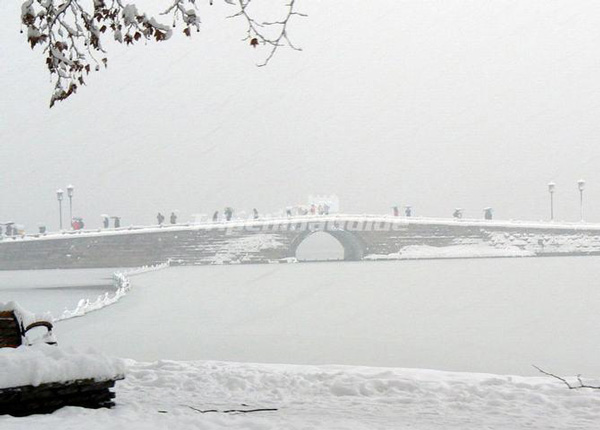
Print with Tissue Paper Overlay
IHL Cat. #2458.06
蘇州街頭 Sūzhōu Street with tissue overlay
The back of the portfolio's interior contains the below label serving as its colophon:
Colophon
1 Collotype printing had its first commercial use in Japan in 1889. The collotype process was versatile and could produce high quality images on different types of paper. Collotype prints can be readily identified by the presence of image reticulation, a product of the finely cracked gelatin plate used to print the image, which can be seen under magnification. The size of the reticulation varies from print to print, but cannot be seen by the naked eye. The image can be a variety of colors. Prints made from collotype plates can be either hand printed or printed using a press.
Seihō's China Trips
When Seihō visited China in the early 1920s, China was still suffering under the Unequal Treaties foisted upon it beginning in 1842 which obligated China, under military threat, to offer concessions to foreign powers, essentially ceding territorial control of important ports and cities to a host of European imperialist powers, Russia, the United States and Imperial Japan. Many of the areas visited by Seihō to sketch and photograph were under Japanese control at that time, which they would maintain until their defeat in 1943.
The area visited by Seihō is known as Jiangnan (lit. “South of the [Yangtze] River") and is comprised of "present-day central and southern Jiangsu province, Shanghai, Zhejiang province, southern Anhui province and some regions in Jiangxi province. Cities that fall under this definition include Suzhou and Nanjing [and Zhenjiang] in Jiangsu, Hangzhou and Shaoxing in Zhejiang, Huangshan and Anqing in Anhui, and Wuyuan in Jiangxi."1
Map of Jiangnan Area (within red dotted line circle) Visited by Seihō
click on image to enlarge
image source: https://commons.wikimedia.org/wiki/File:Jiangnan.png
SY, CC BY-SA 4.0 <https://creativecommons.org/licenses/by-sa/4.0>, via Wikimedia Commons
In the below photograph we see Seihō in his white travelling cloak and geta sketching, surrounded by his entourage. The photographer who took this photo is unknown, but it was likely taken with one of the two state-of-the-art Eastman Graflex cameras Seihō, an avid photographer, brought along. (See the portfolio prints Sūzhōu Twin Pagoda Temple, Sūzhōu Street and View of the Yangtze River for examples of the artist's photographs that he would later use in creating his ink and color on silk paintings that became the basis for the prints.)
The artist with his sketchpad in China, 1920-1921
West Lake, Hangzhou and Duan (Broken) Bridge
"Lovely West Lake, near scenic Hangzhou on China’s east coast, has been celebrated as a major tourist site since the twelfth century. Now as then, visitors boat to its islands, stroll through its gardens, worship in its temples, and immortalize it in poetry and painting. Hangzhou and West Lake have long served as icons of Chinese landscape appreciation, literary and artistic expression, and tourism."1
"Broken Bridge is located at the eastern end of the Bai Causeway on West Lake (Xi Hu), Hangchow (Hangzhou). Also known as Bao You Qiao (宝佑桥, the Bridge of Treasure Blessing) or Duan Jia Qiao (段家桥). The bridge shown in this photograph was rebuilt in c.1914."2
"The stone arched broken bridge is where the character of a famous Chinese folktale Xu Xian and a beautiful girl, who is actually a white snake, first met and fell in love with each other. After a snowfall, when the snow on the more exposed side has melted, with the shade side remaining white, it looks as if a long white belt has been ripped apart on the thus earning the name 'melting snow on the broken bridge'."3

image source: https://www.tripchinaguide.com/photo-p31-7380-lingering-snow-on-the-broken-bridge.html
1 from the University of Washington Press description of the book Rise of West Lake A Cultural Landmark in the Song Dynasty By Xiaolin Duan
https://uwapress.uw.edu/book/9780295747125/the-rise-of-west-lake/2 https://www.hpcbristol.net/visual/ar01-004
3 https://www.tripchinaguide.com/photo-p31-7380-lingering-snow-on-the-broken-bridge.html
Print Details
| IHL Catalog | #2458.03 |
| Title | West Lake, Hangzhou 西湖斷橋 |
| Series | Scenes of China 支那風光圖繪 (支那風光図絵) Shina fūkō zue |
| Artist | Takeuchi Seihō (1864-1942) |
| Signature | 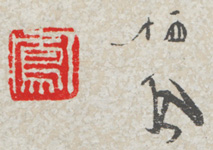 |
| Seal | unread seal (one of hundreds of different seals used by the artist) |
| Publication Date | 1936 (Shōwa 11) |
| Edition | first and only |
| Publisher | Ōtsuka Minoru 大塚稔 of the publishing house Ōtsuka Kōgeisha 大塚巧藝社 Note: Ōtsuka Kōgeisha founded in 1919 in Tokyo by the photographer Ōtsuka Minoru (1888-?) specialized in fine art photographic printing and collotype printing with the objective of popularizing art and "preserving art and culture for future generations.". Still operating today in Kyoto They still operate today with the motto of "preserving art and culture for future generations". Their website can be found at http://otsukakogei.co.jp/ |
| Printer | unknown |
| Impression | excellent |
| Colors | excellent |
| Condition | excellent |
| Miscellaneous | |
| Genre | nihonga; fukusei hanga |
| Format | dai ōban |
| H x W Paper | 16 5/8 x 20 3/4 in. (42.2 x 52.7 cm ) |
| H x W Image | 12 11/16 x 16 15/16 in. (32.2 x 43 cm) with silver border 12 1/2 x 16 3/4 in. (31.8 x 42.5 cm) without silver border |
| Collections This Print | Harvard Hollis Library 990153014300203941 (no images shown) |
| Reference Literature | |
3/15/2021 created


